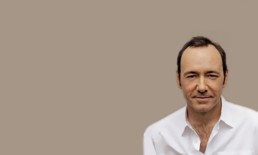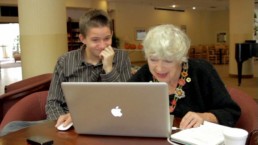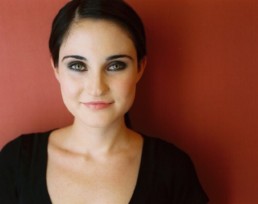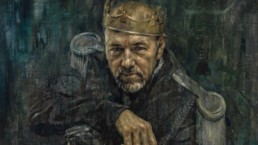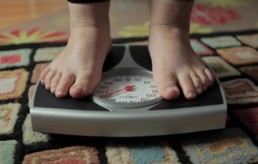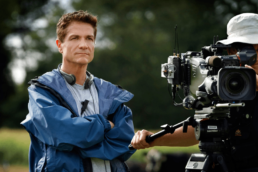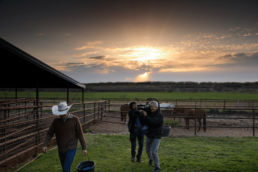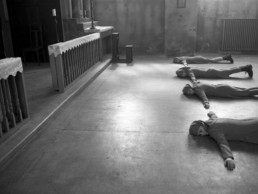Kevin Spacey on 'NOW: In the Wings on a World Stage'
There aren't many people who can command a room by simply walking into it. With his reddish chambray button-down shirt, grey suit, Boston Strong woven bracelet, and a backpack of tennis rackets, Kevin Spacey is the epitome of cool.
Swiftly walking to our table, he sets his bag down and looks each of us in the eye as if to imply that these next twenty minutes are going to be both enlightening and fun. During our conversation, I notice that his answers aren’t just responses, they are stories, each one more vivid and colorful than the next. Even off camera, or stage, in this case, Kevin Spacey is a storyteller at heart, engaging and captivating our intimate roundtable, talking to us as if we are his fellow champions rather than “critics.” Spacey plays the devilish Richard III in the Sam Mendes directed play NOW, and it's for this reason why we're gathered together today. As excited as I am to hear about Spacey's experience traveling cross-country with a theater troupe performing one of Shakespeare's most notable works, there is so much more I wish I could ask him about his entire career (although I don't think his team would allow me the required twenty hours to do so). We do manage, however, to get in a few good questions about Francis Underwood and House of Cards, and the stories don't stop. We begin:
WHEN YOU DECIDED TO DO THIS PRODUCTION AND TAKE IT AROUND THE WORLD, AT WHAT POINT DID THE IDEA OF DOING A DOCUMENTARY COME INTO PLAY?
The conversations started a little bit with Sam Mendes [play director] in the first year of The Bridge Project. There were 3 seasons where Sam directed 5 productions… Richard III was the final. We started talking in the first season, I think it was probably after I went to Epidaurus to watch Simon Russell Beal do The Winter’s Tale and I was like, ‘Oh my God, whatever we do, we have to bring it to this theater. This is the most unbelievable theater.’ And then I said, ‘Maybe there’s a way we can capture this experience’ because… it’s probably been about 35 or more years since a theater company has gone around the world and done this kind of tour. It just isn’t done anymore. So then Jeremy [Director]… came to me and said ‘I think you should document this’ and I was like that’s exactly what Sam and I have been talking about. I was quite reluctant about what “it” was going to be, to give parameters and say ‘this is what we’re trying to do,’ it was more like ‘Just fucking capture it!’
When I was shooting last season on House of Cards, Jeremy and our editor came to Baltimore and for 11 weeks we cut what is now the film.
WAS THERE A PERIOD OF ADJUSTMENT FOR THE ACTORS TO GET USED TO THE CAMERAS?
There were some at the very beginning, like Gemma Jones, never wanted the camera in her face. She was like ‘Get that fucking thing out of my face.’ She was very clear about it. But, as time went on, she started to get to know Jeremy and she likes the boys as you get from the film. So she started to soften up and then by the time we’re halfway through she’s lifting up her skirt.
[Laughter]
Also, people didn’t know what it was for. It was never like, ‘Ok this is going to be a PBS documentary, or it’s gonna be on HBO… we just literally didn’t know how it was going to end up being and then how it was going to end being distributed if at all. It could have been just a very expensive home movie.
DID YOU FILM THE PLAY IN ITS ENTIRITY?
It wasn’t designed that way… and it wasn’t what we set out to do.
WHAT ABOUT THE EPIDAURUS EXPERIENCE?
I have to say the Epidaurus experience was unparalled; no experience I ever had in a theater has ever been quite like it. To rehearse in that space over a number of days was quite remarkable, but it’s a very, very different venue when it’s empty than when it’s full. The first time I saw it full was when, well, we had to wait for it to get really dark, it was like 9:15 at night when we could actually start the play. Also because you can’t get 14,000 people down to the bathrooms in less than 2 hours- there was no intermission in Epidaurus, we did it straight through. I remember I was backstage and the green light goes on and that’s your cue to walk out the door, and I remember I scurried across the stage and sat down in the chair and I went like this…
[Slowly raises his head towards the sky]
And I went [giant gasp] ‘ohhhhh fuck.’
[Laughter]
And Sam Mendes said to me after that performance, ‘Oh my god, it was the most terrifying thing to watch you for like the first half hour because you were like, breathing for four people. Literally, I looked up and it was like a wall of people, a human wall that went as far as you could fucking see.
It took us 2 performances to learn how to play that space. I guess I should explain that the difference in playing different theaters is that it's all about how you hear your own voice. That's what acoustics are. Acoustics are about measuring how much energy and vocal power you need to be heard and the only way you can measure that is when you hear your voice back. The audience sucks up a lot of that vocal power but in a place like Epidaurus, which has been built by geniuses, the human voice can carry all the way to the top. I had friends who came and, one night, sat very close and sat at the very top the next night and said they could hear better up there than the could [up close].
YOU'VE WORKED WITH SAM MENDES BOTH IN THEATER AND ON FILM, DOES HE CHANGE HIS DIRECTORIAL STYLE WITH THESE DIFFERENT MEDIUMS?
What was great about Sam when we first worked together was, even though American Beauty was his first film, he took the best of theater and applied it to making a movie. So we rehearsed it for 2 weeks like a play with the entire cast. Everybody was there, no matter how big or small the parts were. We taped all the sets out on this big soundstage and we rehearsed every single scene, so by the time we got to the set, we knew what we were doing. We had answered the big questions. We were ready to work and discover it on film. [Sam] is also one of those rare directors who not only give you a great direction, but they know when to give you that great direction. There are times when I would have been doing something for weeks in a particular way and then in the third preview Sam would go, 'I think tonight we try it this way, I don't think the way you've been doing it is right' and I'd go, 'Well didn't you fucking tell me that sooner!' He'd be like, 'It's because you wouldn't have been able to take the note 6 weeks ago, but now you can. You understand more now than you did then.' It's about a director watching how actors are developing and shifting and changing and when they're ready for a note, he brilliantly knows how to give it to you.
IT'S NOT UNTIL I SAW THIS MOVIE THAT I REALIZED THERE IS A CORRALATION BETWEEN FRANCIS UNDERWOOD [HOUSE OF CARDS] AND...
Not just a correlation! Michael Dobbs [author of the original novel] based the character of Francis on Richard III. That's why direct address exists in House of Cards. I know a lot of people think Ferris Bueller created direct address…
[Laughter]
But he didn't. There's a guy named William Shakespeare and he invented direct address in this play. That's why, for me, it was this amazing circumstance that I closed this play in March of 2012 and on April 28th, I started shooting House of Cards. I cannot tell you what that meant for me in terms of how I approached House of Cards.
DO YOU THINK YOU COULD HAVE DONE HOUSE OF CARDS WITHOUT COMING OFF OF RICHARD III?
I don't think I could have done House of Cards if I haven't spent the last 10 years doing theater. Absolutely… There is no doubt that both of these characters are investigations into the quarters of power, into the nature of power, and that they're both characters that have such a remarkable ability to predict the way someone will respond, that they're able to be 16 moves ahead in the chess game. That's why they generally get what they want.
When it came time for me to start doing the direct addresses in House of Cards, the memory of that relationship [during Richard III] was so burned in me, that it really helped me because now I'm just looking down the barrel of a lens. I don't have eyes. I've had to make a slight adjustment from thinking of so many people to just trying to think of my best friend whoI'm telling things to that I wouldn't tell anyone.
ONE THING I REALLY APPRECIATED WAS THE NOWNESS, BEING IN THE PRESENT. DO YOU FIND THEATER THERAPEUTIC BEING JUST SO IN THE MOMENT?
Yeah. Let me put it to you this way, one of the reasons why I wanted to make the movie was that a lot of times over the last few years people looked at me like a really confused puppy. Like, 'Why do you do theater?' Here's what's incredible about the comparisons between the experiences for an actor. Theater is organic. Film is not. Theater, you come everyday and work with a group of people and you all get to do the whole thing every night. In film, you work in 2-3 minute bits and it's never in chronological order, and then someone takes that away and makes it look like it all happened, or that you gave that performance. But you might have given that performance in one take that way, another take that way and the way they put it all together makes it look like you did it.
For all those people who think [theater] must all be the same, I often use the analogy of tennis. If you go out and play tennis for 8 nights, yeah it's the same rules, but it's a different game every time you're out on that court. You're working on a different part of your game and your partner is working on another part of their game. You add to that the act of being watched, and that changes it.
Theater is alive and it is now. And then it's gone.
Another thing I remember, is that no matter how good I may be in a movie, I'll never be any better. It's frozen. But in theater, I can be better tomorrow night. The journey you go through as an actor is incredible.
Review: 'Cyber-Seniors'
The thought of teaching senior citizens, many of whom are in their late 80's, how to navigate a computer, let alone the internet, sounds more like a punishment than a reward. Why anyone at that age would willingly subject themselves to such an ominous learning curve would make no sense to most elderly people, but to these seniors, the motivation of reconnecting with family members and loved ones is much stronger than updating their social media status. Director Saffron Cassaday documents the heartwarming journey of seniors learning all about the internet in the film Cyber-Seniors, a comedic story that is sure to bring a smile to your face.
Other seniors get confused when they can't access their email after typing "www.email.com" into the search browser.
In the world of these senior citizens, letters are written by hand, so the very thought of sending an email is mind-boggling. Luckily, there's now a program called Cyber Seniors in which teenage students sign up to guide the elderly in navigating the web. The comedic moments are organic; 88-year-old Shura is awestruck that she can "chat" with fellow Cyber Senior Ellard, 89, on Facebook. 76-year-old Annette is only concerned with dating websites and sets up a profile right away. Other seniors get confused when they can't access their email after typing "www.email.com" into the search browser.
To engage this group, a video competition is created to see who can get the most views on YouTube. With the help of their teenage mentors, the seniors set out to make a video based on what is important to them. 93-year-old Marion channels her inner Snoop Dogg and makes a rap music video about still having all of her teeth, as she sports a sideways baseball cap and all of her vintage art-deco necklaces. Shura loves to cook, and decides to demonstrate how she makes lunch, which consists of ironing her grilled cheese sandwiches (which actually works)! Other videos are just as funny, which include golf and exercise tips for seniors, how to pick up men, and gardening tricks.
Despite its amateur, low budget "look," Cyber-Seniors should be taken seriously as a documentary. There are unexpected emotional moments that affect the director, unintentionally pointing out the importance of family and desire for connection. You will fall in love with the men and women and can't help but laugh alongside them as they enter the vast world of technology for the first time. Cyber-Seniors is a heartwarming story that proves old dogs can learn new tricks, and then brag about it on Facebook.
https://www.youtube.com/watch?v=9p_kc6z8W3Q
Saffron Cassaday on 'Cyber-Seniors'
Talking on the phone with Saffron Cassady seems so natural, her laid back nature and confidence is just the sort of personality I would expect anyone to completely trust. It's no wonder why her feature documentary Cyber-Seniors is a successful first film from the director. Being an experienced comedy actress and editor, Cassaday makes an engaging film about senior citizens exploring the internet for the first time, learning all about Facebook, Youtube and online dating. A humorous plot line greatly executed for an equally funny and heartwarming film. We begin:
WHAT WAS THE CASTING PROCESS LIKE TO FIND THESE SENIORS?
We got into two retirement residences that allowed us to film. We did little presentations to the seniors to try and get them interested. I think we had 30-40 seniors sign up. So we started by giving all of them lessons and filming all of their lessons, and then we quickly narrowed it down to the ones that were really comfortable in front of the camera and were really fun and funny.
ONE OF MY FAVORITE PARTS IN THE FILM IS WHEN ONE LADY TRIES TO ACCESS HER EMAIL BY TYPING WWW.EMAIL.COM. WERE THERE OTHER MOMENTS THAT WERE AS FUNNY OR HEARTWARMING DIDN'T MAKE IT INTO THE FINAL CUT?
There's one storyline that didn't make it into the final cut. The one senior Annette, who's a major character, said in her first lesson that her reason to get online was to look up her old high school friend. She tried to find her on Facebook and couldn't find her and then she posted a Craigslist ad, looking for this person, and she got a response from the woman's son who said here's her Skype address, add her on Skype. When [Annette] added this woman on Skype the woman wanted nothing to do with her.
OH NO...
Yeah it was kind of sad, but kind of interesting. It was like the dark side of the internet because Annette was pretty hurt by it. In the end we didn't use the footage.
BEING THAT YOU'RE AN ACTRESS AS WELL AS A DIRECTOR, HOW DID YOU APPROACH THIS FILM?
Well I started working as an editor about 4 years ago as a side gig to my acting, and I really think having an editing background helped me with this film. I usually edit comedy shorts that I act in, so that was where my experience was… doing comedy short videos. I really went for the punch lines first [when editing] and that helped me weave the story together and focusing on things that really drew me to the project.
HOW DID THE YOUTUBE VIDEO COMPETITION COME ABOUT?
When Shura made her YouTube video, we didn't know what she was going to make. She was really into watching YouTube cooking tutorials and she said she wanted to make one but she was upset because she didn't have a full stove in her retirement residence so that's why she makes the grilled cheese sandwich the way she makes it.
[Laughter]
And no, we didn't know what to expect, we didn't know it would be that funny.
DID YOU GET ANY FUNNY MATERIAL THAT YOU WOULD USE FOR ANY SKETCH COMEDY VIDEOS?
Haha, I hadn't thought of that but yeah, definitely, there's a lot of material there. It's been my life for 2 years so it's constantly on my mind.
WHAT'S YOUR REACTION BEEN TO ALL THE PUBLICITY THE FILM IS GETTING?
It's fantastic, I mean we're so surprised. The main feedback that we usually get is that people find the film way more entertaining than they expected to. I think a lot of people think a documentary with seniors is going to be very educational, but it's not. It's got a lot of heart to it and there's a lot of funny moments so we're really happy that people are kind of recognizing that and enjoying it for that reason.
HAVE YOU KEPT IN TOUCH WITH THE SENIORS IN THE SOCIAL MEDIA WORLD?
Yeah I'm Facebook friends with all of them! Haha. Shura unfortunately passed away last November but she was the most active online. By the end of shooting, it was easier to get in touch with her over Facebook then by calling her. Even like a week before she passed away, we were having a Facebook conversation. It happened very fast, sudden and sad. But yes, we keep in touch still.
DO YOU HAVE ANY ADVICE FOR PEOPLE WANTING TO MAKE DOCUMENTARIES?
Just go for it. You can get so stuck not knowing what to do or when to start, and it is kind of terrifying. I thought that for a first film, a documentary would be easier than a narrative feature because I thought you don't have to have any set lists, you just show up, point and shoot. But the reality of it is the editing process is a monster because you have to come up with the story. Once you're into it, it becomes easier.
Review: 'NOW: In The Wings On A World Stage'
At this point in his career, anything that Kevin Spacey touches turns to gold. Following the incredible success of House of Cards, the actor returns to the big screen in a wholly different way with the documentary Now: In the Wings on a World Stage, serving as both producer and talent. Now follows Spacey and a cast of stage actors from The Bridge Project as they travel the world performing Shakespeare's Richard III with Sam Mendes directing, who's previously worked with Spacey on the classic film American Beauty. Starting with a performance at London's Old Vic Theater and ending in Doha, Qatar, Now is a unique concept for a film; part "behind the scenes" and part travel diary, it inspires the inner wanderlust and suppressed theater kid in all of us.
As the house lights dim and the curtains open on various stages across the world, it's clear that this performance of Richard III will be taken to a whole new level.
Together as creative collaborators, Spacey and Mendes are able to explore the nuances and emphasize the difference between live theater vs film where, unlike a film, a play is unique to each performance, giving the experience the ability to live and die onstage, with memories as the only form of remembrance.
Theater is a house of cards, no pun intended, and as Sam Mendes puts it, it's one inch away from absurdity.
Spacey makes Shakespeare enjoyable, adding his quirks and trademark smoldering eyes to the tyrannical part he plays. His mastery of accents easily transforms him into Richard III, and while it's enjoyable to watch him act on stage, what is even more fun is to see his method of getting into character, a process we typically don't have access to.
The purpose of the documentary is to portray the fact that theater is more than just empty performances; the reason the players at The Bridge Project perform is to create a unique experience between the actors and audience. Spacey and his cast succeed in bringing enjoyable Shakespeare performances to people all over the world by engaging with audiences who may have once found it dull. Theater is a house of cards, no pun intended, and as Sam Mendes puts it, it's one inch away from absurdity.
Even though we missed the live shows, Now: In the Wings on a World Stage is as close to watching the original plays as viewers can hope to get. What Spacey and crew share with the audience is more than just the stage, they share emotions and experiences which authentically translate from stage to screen. Now is not the type of film that would probably be viewed more than once, however, the takeaway is strong; theater is alive and well and continues to impact audiences everyday with its message.
https://vimeo.com/87661857
Review: 'Fed Up'
The next time you're holding a package of food, take a look at the nutritional facts. There, you'll see the usual suspects: calories, fat, and carbohydrates stated in bold, with their individual daily value percentage listed on the right. What often goes unnoticed, yet should be taken seriously, is the sugar component.
Notice how there is no daily value percentage listed next to sugar? No, this is not an oversight, but purposefully left off of ALL food packaging. There is no recommended intake percentage for sugar because that number varies depending on who you ask; Most big food companies are in favor of adding more sugar to foods to appeal to consumer's tastes, but realize that if people knew how much sugar they were actually eating, they might stop buying those products all together.
The impact of this negligence surrounding the health and nutritional well-being of Americans is very well documented in the film Fed Up, which is sure to leave you second guessing your dietary habits.
For example, Fat-Free sounds like a better alternative, but what Fat-Free often means is double the sugar.
Katie Couric takes on the role of executive producer as well as lends her voice as narrator. She mentions that many years ago during one of her regular scheduled newscasts, she did a story on obesity in America. The perception of "more exercise" to achieve weight loss didn't sit well with Couric, as there was no emphasis placed on responsible eating habits.
Fed Up aims to stop the misconception that exercise is the only way to achieve weight loss by uncovering the hidden secrets within the food industry, which reveal that "healthy foods" may not be all that "healthy." For example, Fat-Free sounds like a better alternative, but what Fat-Free really means is double the sugar. Less fat but more sugar doesn't do us any favors, in fact it's considered even more detrimental to our health.
In true documentary fashion, we follow three subjects on a personal journey; in this case it's three children battling obesity. Their social lives are nearly non-existent as they blame their insecurities on their weight. Throughout the film , we not only become invested in the welfare of these children, but learn from nutritional experts their take on why the government, along with the Big Food industry, is not being honest with consumers.
Fed Up's motto is simple, "Junk is still junk even if it's less junky." This generation is the first generation projected to live shorter lives than their parents. It's a scary prospect, which is why praise should be given to films like Fed Up for bringing awareness to such a pertinent issue.
As one of the Official Selections of the 2014 Sundance Film Festival, Fed Up is one of the better food-related documentaries out there, definitely worth a watch for not just the health conscious, but anyone who wants a better quality of life.
https://www.youtube.com/watch?v=aCUbvOwwfWM
Director James Moll on 'Farmland'
James Moll is only a "T" away from achieving the mythical "EGOT"; for all you non 30 Rock fans, this means that Moll has acquired an Emmy, a Grammy and two Oscars to date. An impressive list of awards that keeps growing, and his documentary Farmland easily joins the high ranks of his previous work. In Farmland, Moll gets his hands dirty as he follows farmers all over the country and captures the struggles and joys of the day to day lives of some of America's hardest working people. I chat with James via phone the morning after his Tribeca premiere of the documentary. Needless to say, spirits are high. We begin:
YESTERDAY WAS A BIG DAY FOR YOU...
Yesterday was the premiere of Farmland in New York City, very exciting. It was fun to watch the film on a big screen, with a big audience, and then to hear reactions for the first time. For so long it's been just me and the editor in an editing room.
WHEN YOU WERE FILMING, COULD YOU RELATE TO THESE FARMERS? JUST LIKE THE FILMMAKING PROCESS, THEY PUT SO MUCH WORK INTO THEIR PRODUCT WITHOUT REALLY KNOWING WHAT THE RESULT IS GOING TO BE?
That's the first time I've heard that question, that's a great question! It's true, yes, I do go into each project not exactly knowing what the outcome is going to be. Just wanting to be a fly on the wall with a camera and to follow people and see what it is they do everyday. Even in the interviews that I do with them, I go in with an idea of what I'm going to ask and talk to them about, but it always takes a turn and goes somewhere unexpected.It's always an experience of exploration, you know?
DID YOU GET A CHANCE TO LEARN ACTUAL FARMING TECHNIQUES WHEN YOU WERE FILMING?
A little bit, but not so much. I wasn't focused as much on the "how to" of farming as much as the "who" of farming. Who are these people that are growing our food? What are they like, what are their families like, what's it like living on a farm… that's what interested me more.
WHAT WAS YOUR MAIN REASON FOR MAKING THIS FILM?
For me, the approach was general- it was "who are they?" And I didn't know what to expect.
THIS MAY BE A BY-PRODUCT, BUT HAVE YOU CHANGED YOUR EATING HABITS AFTER MAKING FARMLAND?
Haha, no I haven't changed my eating habits, although I do feel more comfort with having a sense of where the food is coming from. My friends are always putting stuff on Facebook about what I should or shouldn't eat, what's good and what's bad, and I don't know what's true! For me, it was really interesting to just see firsthand, and meet firsthand, farmers. I'm from Los Angeles and grew up in the middle of the city and I've never been on a farm.
WHAT WAS YOUR CASTING PROCESS?
We completely approached them out of the blue, the power of Google!
FARMERS, BY NATURE, AREN'T REALLY IN THE SPOTLIGHT, SO WERE THEY EXCITED WHEN YOU ASKED THEM TO BE A PART OF THIS DOCUMENTARY?
I profiled farmers all in their 20's, the next generation of American farmers, and I think by and large the younger farmers are interested in having people know about what they do and having people come visit their farms. Other [farmers] hung up on us! They weren't interested, but then again we're just a stranger calling up out of the blue so I can understand that.
WHAT WAS YOUR EXPERIENCE LIKE TRAVELING ALL ACROSS THE COUNTRY FILMING YOUR SIX SUBJECTS?
Logistically it was challenging, but fascinating. Every farm is different, so it was a constant learning experience. I'm hoping that the movie will give the audience the same experience that I had in going. I'm hoping that people will come away from this movie and feel like they now know a farmer.
A REALLY NICE TOUCH WAS THE "THIS LAND IS YOUR LAND" RECORDING AT THE END, DID YOU APPROACH EVERCLEAR AND LIZ PHAIR TO COLLABORATE ON THIS SONG?
Yes, the editor Tim Calandrello who I've worked with before on my film about the Foo Fighters [Foo Fighters, Back and Forth ] and he's really into music, and it was his idea to use this rendition of "This Land is Your Land." You would think, 'ok, you're making a movie about farmers and really? You're going to use 'This Land is Your Land?' But Tim had played this recording that Everclear had done a few years back and I though it was great! So we approached them and asked if they wanted to do a version for the film and that's how it all came together.
Review: 'Farmland'
If someone was to ask you to name a farmer, I'm guessing 99% of people would say Old MacDonald, or at least that's what I would have said before watching Farmland, the documentary that is shedding light on a decreasing population of individuals who are responsible for much of the meats and produce we consume every day. Academy award-winning director James Moll gets his hands dirty as he travels across the country to talk to the next generation of farmers, all between 20-30 years old, who may be some of the most underrated yet hardworking people in the business.
Beautiful imagery of vast landscapes fill the screen from the very beginning. There's a peacefulness to the open air and early morning sun. We meet the farmers one by one, each from a different part of the country and each specializing in their own product, some meat, some produce, some strictly organic. During their conversations, Moll discovers that these people love what they do and wouldn't want any other career, however, the constant scrutiny from outsiders and people who consider farming to be a lower class profession does take its toll. But the judgement doesn't deter these farmers from pursuing their passion, and the grit and determination they possess will leave audiences inspired.
The most sobering takeaway from the entire film is the fact that the average age of a farmer today is 65, and because of unfair cultural judgement, fewer and fewer young people are going into farming and the agricultural business in general.
As other food documentaries before it, Farmland takes an honest and often unsettling look at the gritty process of how our food makes its way to the table and a lot of times, it's not pretty. While the farmers shown in this documentary do not participate in inhumane practices, there's no denying that these practices still exist almost everywhere. Undercover cameras capture male baby chicks being thrown into trash bags for garbage, pigs being boiled alive, and other very hard to watch realities. It's not an easy watch, but a necessary one.
Farmland exposes the reality that this industry is still a male-dominated one, Margaret Schlass is the only female farmer profiled. However, that's not the main issue. The most sobering takeaway from the entire film is the fact that the average age of a farmer today is 65, and because of unfair cultural judgement, fewer and fewer young people are going into farming and the agricultural business in general.
When this last generation of farmers passes, who will cultivate our food? It's a serious issue that needs to be raised, and Moll does a great job of making these farmers relatable to audiences, even those of us who have never planted a seed. The best part about Farmland is that at the end, you really feel like you have personally met a farmer.
https://www.youtube.com/watch?v=3x8faGknw_8
Review: 'Ida'
Ida, the quiet, yet powerful, art house film shot in black & white is so captivating, it gives audiences the ability to feel and see the nonexistent colors. The haunting beauty in the filmmaking is equally on par with the incredible talent from Polish actors Agata Kulesza and Agata Trzebuchowska, whose performances will be talked about long after the film is over.
Director Paweł Pawlikowski has a masterpiece in Ida as it defies every cinematic challenge and is truly a gift to those who watch it.
Ida takes place in 1960's Poland and tells the story of a young girl about to take her vows to become a nun. Ida (Agata Trzebuchowska), or Sister Anna, is set to be welcomed into the church when she is told by the Mother superior that she must visit her only living relative before making her vows.
Ida is an orphan and was left at the convent as an infant, so this is the only world she's ever known. With her orders given, Ida packs a small suitcase and sets off to see her Aunt Wanda (Agata Kulesza), but little does she know that after this visit, her life will never be the same.
Pawlikowski's images are so powerful and striking, it transforms every frame and scene into a piece of art.
Storyline aside, Ida has the most interesting and fearless camerawork I've seen in a long time, Pawlikowski's images are so powerful and striking, it transforms every frame and scene into a piece of art.
His use of space and framing is untraditional; where most directors give their actors head room in a frame, Pawlikowski pushes in the opposite direction. For instance, Ida is talking to Wanda facing left, yet the framing is to the extreme right, leaving Ida barely on the screen at all. The English subtitles also move around screen to accommodate Pawlikowski's framework. It's a welcoming change and only adds to the films beauty.
Even in black and white, Ida is vibrant and pulsing with powerful imagery. Trzebuchowska's natural and angelic beauty belongs onscreen, her name is one sure to be appearing in many future films. Without a doubt, Ida is one of the best films I've seen this year.
https://www.youtube.com/watch?v=oXhCaVqB0x0

